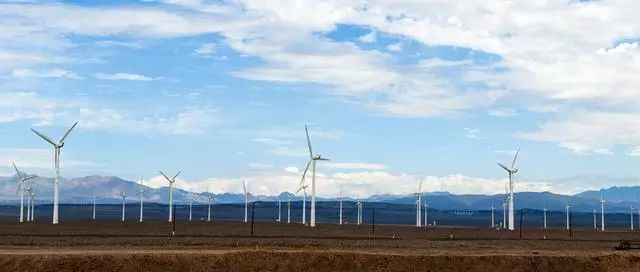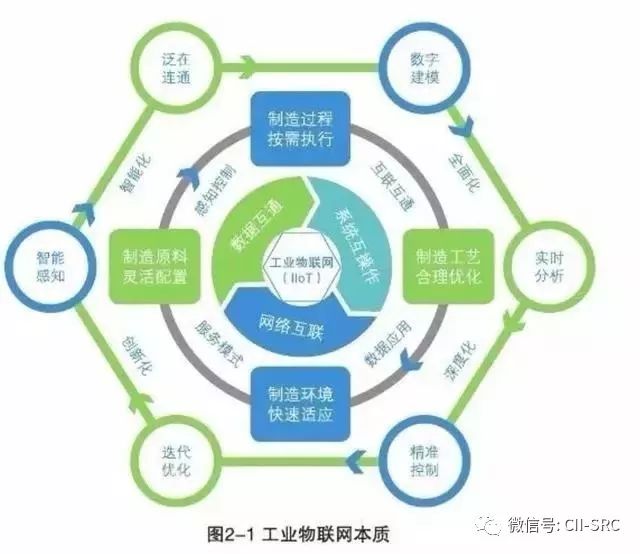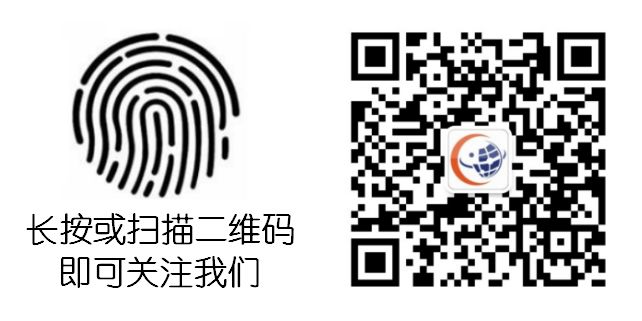
(1) Real Application Scenarios of Industrial Internet
According to the white paper from the Industrial Internet Industry Alliance in China, there are currently four main application scenarios for industrial internet platforms: (1) Production process optimization for industrial sites; (2) Management decision optimization for enterprise operations; (3) Resource optimization and collaboration for socialized production; (4) Management and service optimization for product lifecycle.
The digital industry of the Internet of Things truly disrupts agriculture, urban infrastructure, and healthcare, and will continue to expand into the following industries: solutions for the water industry, empowerment of the oil and gas industry, intelligent tracking in transportation, business model optimization in healthcare, workflow monitoring in mining, and enhanced product experience in hotel IoT services.
Currently, China’s manufacturing industry is promoting and transforming, and both the industrial internet and the industrial Internet of Things are crucial. However, there is still a long way to go in terms of security issues, technological foundations, and practical needs that need to be explored and optimized.
(2) Key Technologies of Industrial Internet of Things
Through various types of sensors, information is obtained, transmitted, stored, recognized, analyzed, and used between objects, between objects and people, and between people.
The key technologies of the industrial Internet of Things mainly include comprehensive perception, information transmission, intelligent processing, and information feedback.Comprehensive Perception refers to the use of modern information collection and acquisition techniques to gather and obtain information about objects anytime and anywhere;Information Transmission refers to reliable information exchange and sharing that can occur anytime and anywhere through various communication networks and the internet;Intelligent Processing refers to the analysis and processing of massive amounts of collected data and information to enhance insights into the industrial production environment and market, achieving intelligent decision-making and control;Information Feedback refers to conveying processed information in the form of program instructions to various production stages to optimize production structure and fulfill production plans.
In summary, the key technologies of the industrial Internet of Things also exhibit four characteristics: perception, connection, knowledge, and control.
(3) Typical Features of Industrial Internet of Things
The “Industrial Internet of Things White Paper (2017)” describes the typical features of the industrial Internet of Things, which I would like to share with you.

Source: 2017 Industrial Internet of Things White Paper
1. Intelligent Perception
Intelligent perception is the foundation of the industrial Internet of Things. Faced with the massive data generated by the industrial production, logistics, sales, and other links in the industrial chain, the industrial Internet of Things uses sensors, RFID, and other perception methods to obtain information data of different dimensions throughout the entire lifecycle of industry, specifically including: personnel, machines, raw materials, process flows, and environmental status information of industrial resources.
There are three information source channels at the perception level.
(1) Traditional Systems. Information collected by traditional information systems often has high value, partly because the data collected is often structured and easy to statistically analyze, and partly because the data collected is often quite important, providing significant reference value for subsequent data analysis. Traditional information systems encompass a wide range of content, such as the common ERP systems. For enterprises, the construction of traditional information systems should be the first step in informatization construction.
(2) Web Platforms. Another important source of information is various web platforms. With the popularity of web applications, especially the widespread use of Web 2.0, the entire web system generates a large amount of data, which is also one of the important data sources for big data systems. Data from web systems has several typical characteristics, such as large quantity, diverse structure, and difficulty in distinguishing authenticity, which necessitates further data analysis to reflect its value.
(3) Internet of Things Systems. Unlike traditional information systems and web systems, most data from the Internet of Things is unstructured and semi-structured. Analyzing this data requires specific processing methods, with common methods including batch processing and stream processing. Common platforms for batch processing include Hadoop and Spark, while stream processing typically uses Spark Streaming, Storm, etc.
2. Ubiquitous Connectivity
Ubiquitous connectivity is the premise of the industrial Internet of Things. Industrial resources connect with each other or to the internet through wired or wireless means, forming convenient and efficient information channels for the industrial Internet of Things, achieving interconnectivity of industrial resource data and expanding the breadth and depth of connections between machines and people, as well as machines and environments.
Information transmission in the Internet of Things relies on wired, wireless, and other media for data transmission. Currently, mobile internet technology is increasingly used to facilitate the information transmission process of the industrial Internet of Things.
The transmission media include two types: wired and wireless. Here, we will not discuss wired transmission. In terms of wireless types, the protocols used include LoRa, NB-IoT, eMTC, WirelessHART, WIA-PA, ISA100, etc.
These protocols are divided into two categories. (1) Low-power short-distance communication technologies, such as IEEE 802.15.4, where the transmission distance between nodes is short: less than 100m; multi-hop routing protocols: CTP, RPL, LLN; (2) Low-power wide area networks (LPWAN), with representative technologies like NB-IoT, LoRa, eMTC, SigFox, etc., which have potential but may not necessarily replace existing technologies. For outdoor large-scale deployment, LPWAN is a good solution. NB-IoT is an improved version based on LTE, with the benefits of technological maturity and the ability to reuse existing base stations. LoRa requires the deployment of LoRa base stations, but it is also applicable in scenarios such as smart parks, and LoRa technology is more open, making it easier for secondary development.
3. Digital Modeling
Digital modeling is the method of the industrial Internet of Things. Digital modeling maps industrial resources into digital space, simulating industrial production processes in a virtual world, leveraging the powerful information processing capabilities of digital space to achieve abstract modeling of all elements of the industrial production process, providing effective decision-making for the operation of the physical industrial chain.
4. Real-time Analysis
Real-time analysis is the means of the industrial Internet of Things. For the sensed data of industrial resources, real-time processing is conducted in the digital space through technical analysis methods, obtaining the intrinsic connection between the status of industrial resources in the virtual and real spaces, further visualizing and intuitively representing the abstract data to achieve real-time response to external physical entities.
5. Precise Control
Precise control is the goal of the industrial Internet of Things. Through the processes of state perception, information interconnection, digital modeling, and real-time analysis of industrial resources, decisions formed in the virtual space are converted into control commands understandable by the physical entities of industrial resources, enabling actual operations and achieving precise information exchange and seamless collaboration of industrial resources.
6. Iterative Optimization
Iterative optimization is the effect of the industrial Internet of Things. The industrial Internet of Things system can continuously self-learn and improve by processing, analyzing, and storing industrial resource data, forming an effective and inheritable knowledge base, model library, and resource library. Targeting the manufacturing materials, processes, technologies, and environments of industrial resources, continuous iterative optimization is conducted to achieve optimal goals.
7. IoT Security
IoT security is the guarantee of the industrial Internet of Things. In fact, the security issues of information systems have always been prominent. The situation is worsened by the emergence of IoT (Internet of Things). The security issues of IoT become more pronounced as the scale of its use expands, but essentially, the contradictions between product cost and security remain unchanged. Many believe that IoT represents an infinite future; however, the reality is that almost all IoT devices connected to the internet are far from ideal and may even introduce new security issues. The unreliable operation and security models of these devices can potentially affect other devices, which need management and inspection. However, in practice, people often overlook this point. IoT devices are also built on many layers of software developed by people, and these devices are often very cheap. The low cost makes it difficult to ensure the security of IoT devices. For instance, if one analyzes the security model of a home network camera, it is likely to be found completely insecure, potentially exposing monitoring content on the internet. Programmers are prone to errors, and software is nearly impossible to be perfect; vulnerabilities will continue to exist. Consumers need to pay attention to the security of these IoT devices. However, in the current IoT market, security is still compromised for the sake of low cost. How to solve this problem continues to trouble people.
(4) Development Stages of Industrial Internet of Things
The first stage: Intelligent Perception and Control. The perception and control stage of the industrial Internet of Things primarily achieves the end intelligence perception of IoT ubiquity, consisting of diversified acquisition and control modules, including various types of sensors, RFID, and short to medium distance sensors and wireless sensor networks, achieving intelligent data collection and equipment control in the industrial Internet of Things.
The second stage: Comprehensive Interconnectivity. The industrial Internet of Things utilizes various sensors, RFID, etc., for data collection, and through industrial gateways, short-range wireless communication, low-power wide area networks, and OPC UA interconnectivity technologies, effectively integrates common informatization technologies with industry characteristics, achieving secure and efficient fusion of heterogeneous networks such as wireless communication networks, industrial Ethernet, and mobile communication networks, fully leveraging the application value of network infrastructure, and innovating service models and optimizing processes.
The third stage: Deep Data Applications. Utilizing technologies such as data mining, data warehousing, and distributed storage, based on cloud computing platform technology, data modeling, analysis, and optimization are conducted, achieving deep development applications of multi-source heterogeneous data. By continuously organizing data through integrated collection and processing, issues of data extraction, integration, and performance optimization are resolved. Hidden predictive information is extracted from data warehouses, potential relationships between data are mined, valuable information is quickly and accurately identified, effectively enhancing the decision support capability of the system.
The fourth stage: Innovative Service Models. The innovation of service models in the industrial Internet of Things mainly focuses on customized services, value-added services, operation and maintenance services, upgrade services, training services, consulting services, and implementation services, widely applied in smart factories, smart transportation, industrial process reengineering, environmental monitoring, remote maintenance, equipment leasing, and other demonstration fields of IoT applications, comprehensively constructing an innovative service model ecosystem for the industrial Internet of Things, enhancing industrial value and optimizing service resources.
Original source: Industrial Control Expert
